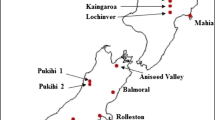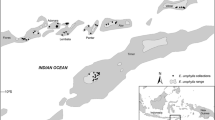Abstract
Quantifying foliar stable carbon isotope discrimination (Δ) is a powerful approach for understanding genetic variation in gas exchange traits in large populations. The genetic architecture of Δ and third-year height is described for more than 1,000 clones of Pinus taeda tested on two contrasting sites. \(\hat h^2 \) for Δ was 0.14 (±0.03), 0.20 (±0.07), and 0.09 (±0.04) at Florida, Georgia, and across sites, respectively. \(\hat H^2 \) for stable carbon isotope discrimination ranged from 0.25 (±0.03) at the Florida site to 0.33 (±0.03) at the Georgia site, while the across-site estimate of \(\hat H^2 \) was 0.19 (±0.02). For third-year height, \(\hat h^2 \) ranged from 0.13 (±0.05) at the Georgia site to 0.20 (±0.06) at the Florida site with an across-site estimate of 0.09 (±0.05). Broad-sense heritability estimates for third-year height were 0.23 (±0.03), 0.28 (±0.03), and 0.13 (±0.02) at the Florida site, Georgia site, and across sites, respectively. Type B total genetic correlation for Δ was 0.70 ± 0.06, indicating that clonal rankings were relatively stable across sites, while for third-year height, rankings of clones were more unstable across the two trials \(\left( {\hat r_{B_{TG} } = 0.55 \pm 0.08} \right)\). Third-year height and Δ were negatively correlated at the parental \(\left( {\hat r_{ADD} = - 0.42 \pm 0.33} \right)\), full-sib family \(\left( {\hat r_{FS} = - 0.54 \pm 0.25} \right)\), and clonal \(\left( {\hat r_{TG} = - 0.30 \pm 0.11} \right)\) levels, suggesting that genetic variation for Δ in P. taeda may be a result of differences in photosynthetic capacity. We conclude that Δ may be a useful selection trait to improve water-use efficiency and for guiding deployment decisions in P. taeda.



Similar content being viewed by others
References
Aitken SN, Kavanagh KL, Yoder BJ (1995) Genetic variation in seedling water-use efficiency as estimated by carbon isotope ratios and its relationship to sapling growth in Douglas-fir. For Genet 2(4):199–206
Baltunis BS (2005) Genetic effects of rooting ability and early growth traits in loblolly pine clones. Ph.D. Dissertation, Univ. Florida, Gainesville, FL, 101 pp
Baltunis BS, Huber DA, White TL, Goldfarb B, Stelzer HE (2005) Genetic effects of rooting loblolly pine stem cuttings from a partial diallel mating design. Can J For Res 35:1098–1108
Baltunis BS, Huber DA, White TL, Goldfarb B, Stelzer HE (2007) Genetic analysis of early field growth of loblolly pine clones and seedlings from the same full-sib families. Can J For Res 37:195–205
Boltz BA, Bongarten BC, Teskey RO (1986) Seasonal patterns of net photosynthesis of loblolly pine from diverse origins. Can J For Res 16:1063–1068
Brendel O, Pot D, Plomion C, Rozenberg P, Guehl JM (2002) Genetic parameters and QTL analysis of d 13C and ring width in maritime pine. Plant Cell Environ 25:945–953
Burdon RD (1977) Genetic correlation as a concept for studying genotype-environment interaction in forest tree breeding. Silvae Genet 26:168–175
Burdon RD (1982) Breeding for productivity-jackpot or will-o-the-wisp? In: Physiology and genetics of intensive culture, Proc. Seventh North American Forest Biology Workshop, Lexington, KY, pp 35–51
Cannell MGR (1979) Biological opportunities for genetic improvement in forest productivity. In: Ford ED et al (ed) The ecology of even-aged forest plantations. Institute of Terrestrial Ecology, Cambridge, pp 119–144
Comstock RE, Moll RH (1963) Genotype–environment interactions. In: Hanson RE, Robinson HF (eds) Statistical genetics and plant breeding. NAS-NRC Publ. 982. NAS-NRC, Washington, DC, pp 53–93
Condon AG, Richards RA (1992) Broad sense heritability and genotype x environment interaction for carbon isotope discrimination in field-grown wheat. Aust J Agric Res 43:921–934
Craig H (1954) Carbon-13 in plants and the relationship between carbon-13 and carbon-14 variations in nature. J Geol 62:115–149
Cregg BM, Olivas-Garcia JM, Hennessey TC (2000) Provenance variation in carbon isotope discrimination of mature ponderosa pine trees at two locations in the Great Plains. Can J For Res 30:428–439
Dickmann DI (1991) Role of physiology in forest tree improvement. Silva Fenn 25:248–256
Ebdon JS, Kopp KL (2004) Relationships between water use efficiency, carbon isotope discrimination, and turf performance in genotypes of Kentucky bluegrass during drought. Crop Sci 44:1754–1762
Emhart VI (2005) Physiological genetics of contrasting loblolly and slash pine families and clones. Ph.D. Dissertation, Univ. Florida, Gainesville, FL, 97 pp
Emhart VI, Martin TA, White TL, Huber DA (2007) Clonal variation in crown structure, absorbed photosynthetically active radiation and growth of loblolly and slash pines. Tree Physiol 27:421–430
Farquhar GD, O’Leary MH, Berry JA (1982) On the relationship between carbon isotope discrimination and the intercellular carbon dioxide concentration in leaves. Aust J Plant Physiol 9:121–137
Farquhar GD, Ehleringer JR, Hubick KT (1989) Carbon isotope discrimination and photosynthesis. Annu Rev Plant Physiol 40:503–537
Foster GS, Shaw DV (1988) Using clonal replicates to explore genetic variation in a perennial plant species. Theor Appl Genet 76:788–794
Gebremedhin MT (2003) Variation in growth, water relations, gas exchange, and stable carbon isotope composition among clones of loblolly pine (Pinus taeda L.) under water stress. M.S. Thesis, Univ. Florida, Gainesville, FL, 83 pp
Gilmour AR, Gogel BJ, Cullis BR, Thompson R (2005) ASReml user guide release 2.0. VSN International Ltd., Hemel Hempstead, p 267
Gonzalez-Martinez SC, Ersoz E, Brown GR, Wheeler NC, Neale DB (2006) DNA sequence variation and selection of tag single-nucleotide polymorphisms at candidate genes for drought-stress response in Pinus taeda L. Genetics 172:1915–1926
Grossnickle SC, Fan S (1998) Genetic variation in summer gas exchange patterns of interior spruce (Picea glauca (Moench) Voss x Picea engelmannii Parry ex Engelm.). Can J For Res 28:831–840
Johnsen KH, Flanagan LB, Huber DA, Major JE (1999) Genetic variation in growth, carbon isotope discrimination, and foliar N concentration in Picea mariana: analyses from a half-diallel mating design using field-grown trees. Can J For Res 29:1727–1735
Korol RL, Kirschbaum MUF, Farquhar GD, Jeffreys M (1999) Effects of water status and soil fertility on the C-isotope signature in Pinus radiata. Tree Physiol 19:551–562
Lauteri M, Pliura A, Monteverdi MC, Brugnoli E, Villani F, Eriksson G (2004) Genetic variation in carbon isotope discrimination in six European populations of Castanea sativa Mill. originating from contrasting localities. J Evol Biol 17:1286–1296
Martin TA, Dougherty PM, Topa MA, McKeand SE (2005) Strategies and case studies for incorporating ecophysiology into southern pine tree improvement programs. South J Appl For 29:70–79
McGarvey RC, Martin TA, White TL (2004) Integrating within-crown variation in net photosynthesis in loblolly and slash pine families. Tree Physiol 24:1209–1220
Monclus R, Dreyer E, Delmotte FM, Villar M, Delay D, Boudouresque E, Petit JM, Marron N, Brechet C, Brignolas F (2005) Productivity, leaf traits and carbon isotope discrimination in 29 Populus deltoids x P. nigra clones. New Phytol 167:53–62
Neale DB, Savolainen O (2004) Association genetics of complex traits in conifers. Trends Plant Sci 9:325–330
Olivas-Garcia JM, Cregg BM, Hennessey TC (2000) Genotype variation in carbon isotope discrimination and gas exchange of ponderosa pine seedlings under two levels of water stress. Can J For Res 30:1581–1590
Pita P, Soria F, Canas I, Toval G, Pardos JA (2001) Carbon isotope discrimination and its relationship to drought resistance under field conditions in genotypes of Eucalyptus globulus Labill. For Ecol Manag 141:211–221
Prasolova NV, Xu ZH, Farquhar GD, Saffigna PG, Dieters MJ (2000) Variation in branchlet d 13C in relation to branchlet nitrogen concentration and growth in 8-year-old hoop pine families (Araucaria cunninghamii) in subtropical Australia. Tree Physiol 20:1049–1055
Prasolova NV, Xu Z, Farquhar GD, Saffigna PG, Dieters MJ (2001) Canopy carbon and oxygen isotope composition of 9-year-old hoop pine families in relation to seedling carbon isotope composition, growth, field growth performance, and canopy nitrogen concentration. Can J For Res 31:673–681
Prasolova NV, Xu ZH, Lundkvist K, Farquhar GD, Dieters MJ, Walker S, Saffigna PG (2003) Genetic variation in foliar carbon isotope composition in relation to tree growth and foliar nitrogen concentration in clones of the F1 hybrid between slash pine and Caribbean pine. For Ecol Manag 172:145–160
Rebetzke GJ, Condon AG, Richards RA, Farquhar GD (2002) Selection for reduced carbon isotope discrimination increases aerial biomass and grain yield of rainfed bread wheat. Crop Sci 42:739–745
Rebetzke GJ, Richards RA, Condon AG, Farquhar GD (2006) Inheritance of carbon isotope discrimination in bread wheat (Triticum aestivum L.). Euphytica 150:97–106
Rytter RM (2005) Water use efficiency, carbon isotope discrimination and biomass production of two sugar beet varieties under well-watered and dry conditions. J Agron and Crop Sci 191:426–438
Samuelson LJ (2000) Effects of nitrogen on leaf physiology and growth of different families of loblolly and slash pine. New For 19:95–107
Silim SN, Guy RD, Patterson TB, Livingston NJ (2001) Plasticity in water-use efficiency of Picea sitchensis, P. glauca and their natural hybrids. Oecologia 128:317–325
Stover CM (2005) A physiological and morphological analysis of the effects of nitrogen supply on the relative growth rates of nine loblolly pine (Pinus taeda L.) clones. M.S. Thesis, Texas A&M Univ., College Station, TX, 62 p
Sun ZL, Livingston NJ, Guy RD, Ethier GJ (1996) Stable carbon isotopes as indicators of increased water use efficiency and productivity in white spruce (Picea glauca (Moench) Voss) seedlings. Plant Cell Environ 19:887–894
Voltas J, Serrano L, Hernandez M, Peman J (2006) Carbon isotope discrimination, gas exchange and stem growth of four Euramerican hybrid poplars under different watering regimes. New For 31:435–451
Williams ER, Matheson AC, Harwood CE (2002) Experimental design and analysis for tree improvement, 2nd edn. CSIRO Publishing, Collingwood, p 214
Xu ZH, Saffigna PG, Farquhar GD, Simpson JA, Haines RJ, Walker S, Osborne DO, Guinto D (2000) Carbon isotope discrimination and oxygen isotope composition in clones of the F1 hybrid between slash pine and Caribbean pine in relation to tree growth, water-use efficiency and foliar nutrient concentration. Tree Physiol 20:1209–1218
Yamada Y (1962) Genotype by environment interaction and genetic correlation of the same trait under different environments. Jap J Genet 37:498–509
Zacharisen MH, Brick MA, Fisher AG, Ogg JB, Ehleringer JR (1999) Relationship between productivity and carbon isotope discrimination among dry bean lines and F2 progeny. Euphytica 105:239–250
Zhang J, Marshall JD, Jaquish BC (1993) Genetic differentiation in carbon isotope discrimination and gas exchange in Pseudotsuga menziesii. Oecologia 93:80–87
Zhang J, Fins L, Marshall JD (1994) Stable carbon isotope discrimination, photosynthetic gas exchange, and growth differences among western larch families. Tree Physiol 14:531–539
Zhang J, Marshall JD, Fins L (1996) Correlated population differences in dry matter accumulation, allocation, and water-use efficiency in three sympatric conifer species. For Sci 42:242–249
Acknowledgements
This research was funded by USDA-CSREES-IFAFS (Award No. 2001-52100-11315). Thanks to Rayonier and MeadWestvaco for providing access to the study sites and to the members of the University of Florida Forest Biology Research Cooperative for financial and in-kind support. We thank Brian Roth, Paul Proctor, Vanessa Tischler, Tania Quesada, and Gogce Kayihan for field and laboratory assistance. We also thank Chris Harwood and David Bush for their helpful comments on an earlier draft of the manuscript.
Author information
Authors and Affiliations
Corresponding author
Additional information
Communicated by R. Sederoff
Rights and permissions
About this article
Cite this article
Baltunis, B.S., Martin, T.A., Huber, D.A. et al. Inheritance of foliar stable carbon isotope discrimination and third-year height in Pinus taeda clones on contrasting sites in Florida and Georgia. Tree Genetics & Genomes 4, 797–807 (2008). https://doi.org/10.1007/s11295-008-0152-2
Received:
Revised:
Accepted:
Published:
Issue Date:
DOI: https://doi.org/10.1007/s11295-008-0152-2




